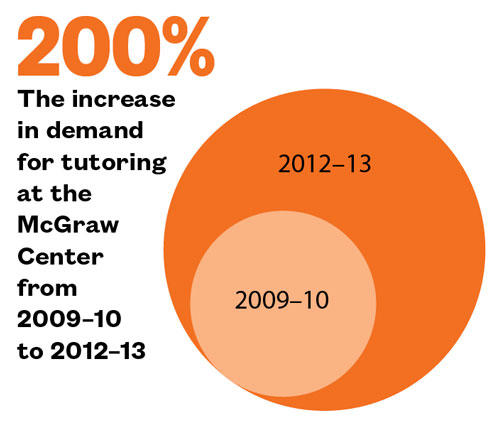Tutoring Takes Off
Students don’t feel stigma in seeking help as demand surges for academic assistance
The number of students showing up for drop-in, group tutoring in quantitative subjects such as chemistry and economics has tripled since 2009, according to Nic Voge, associate director of the McGraw Center for Teaching and Learning. During the 2009–10 academic year, close to 2,000 students visited the center for tutoring, which is free; in 2012–13, the number was 5,882. During the fall semester, 3,800 students attended tutoring sessions. Tutoring is offered in chemistry, economics, math, physics, and statistics, mostly for introductory courses.
At the Writing Center, 2,139 students sought free, one-on-one help with writing assignments last fall, up 21 percent from a year earlier. During reading period, there was an 82 percent jump in demand from last year to this year. The residential colleges offer one-on-one peer tutoring, which also has experienced a significant increase since 2010.
“We’re seeing a trend societally for higher-performing students to get academic help,” Voge said, citing similar demands on tutoring resources at peer institutions. The McGraw Center recently has shifted the way tutoring is presented to students — fliers and newsletters now emphasize that tutoring, known as “study hall,” helps students get acclimated to college standards, rather than offering it as a solution to the problem of poor grades. “For tutoring to be beneficial, we want students to get it early — not wait until they’re far behind,” Voge said. His office also expanded its outreach, publicizing its programs to professors, the athletics department, student organizations, even Outdoor Action student leaders.
Christopher McConnell ’14, who tutors in economics, said students regard the center as “a great place to work on problem sets and get some assistance on the material. If there ever was a stigma associated with McGraw, I don’t really sense it anymore.”
To address the surging demand, the McGraw Center increased the number of undergraduate tutors from about 40 in 2012 to almost 60 last fall and began allowing graduate students to serve as tutors.
Typically one tutor works with four to six students, who gather in large rooms at the Frist Campus Center, though a single tutor may work with as many as 20 students for high- demand classes such as introductory economics. “These are facilitated study groups, so students tend to come and work together,” said Lisa Herschbach, who began serving as McGraw’s director Sept. 1. Sessions are held for three hours in the evening Sunday through Wednesday, for 10 weeks each semester.














No responses yet